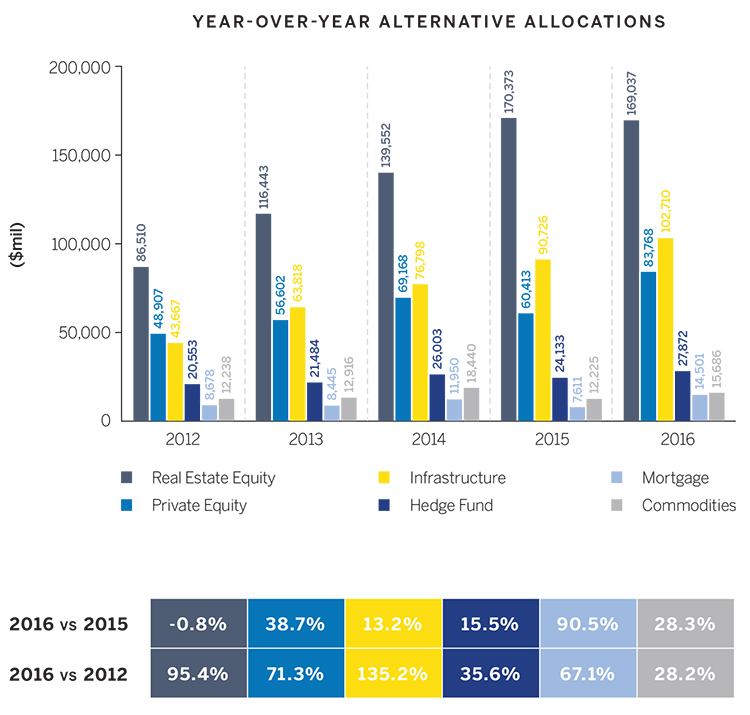Two primary ways to get exposure to global real estate are through direct real estate investments and listed real estate investment trusts (REITs). Benefits Canada asked Tracey Luke, senior director and portfolio manager, and Darin Turner, managing director and portfolio manager, both of Invesco Real Estate, to discuss factors that plan sponsors can consider as they determine allocations to each asset type.

TRACEY LUKE
SENIOR DIRECTOR & PORTFOLIO MANAGER, INVESCO REAL ESTATE

DARIN TURNER
MANAGING DIRECTOR & PORTFOLIO MANAGER, INVESCO REAL ESTATE
WHY SHOULD PLAN SPONSORS THINK GLOBALLY WHEN IT COMES TO REAL ESTATE INVESTING?
TL: The Canadian market has about 2 to 3% of the global direct real estate market, and it’s very focused in two sectors: retail and office. Moving outside of Canada provides access to high-quality opportunities across all sectors [including apartments, and the industrial and specialty sectors]. Also, it offers low correlations to the domestic real estate market and is similarly income-oriented to the domestic real estate market. Therefore, it increases diversification and can help dampen volatility in a portfolio.
DT: From a listed security perspective, real estate investing is about getting exposure to a local market demand-supply environment that can vary around the world. A global perspective broadens a plan sponsor’s investment universe. Additionally, economic growth drives real estate fundamentals, and our belief is that, over the long term, other markets such as emerging markets will have higher growth rates than the United States, so it can make sense to include these opportunities in a portfolio allocation.
WHAT ARE THE BENEFITS AND RISKS OF INVESTING IN GLOBAL DIRECT REAL ESTATE?
TL: Beyond a low correlation to Canada’s direct real estate, global direct real estate has historically had a low correlation to equities and a negative correlation to bonds — so, again, it can help enhance diversification and reduce [portfolio] volatility. That said, investing successfully in direct real estate requires local management and expertise, and that may be daunting to a Canadian plan sitting 5,000 miles away from a foreign real estate market. Legal nuances, currency fluctuations and taxes can all affect returns. To mitigate these risks, most plans use consultants, and/or partner with global asset management firms that have global reach and local execution.
WHERE ARE YOU FINDING THE BEST GLOBAL DIRECT REAL ESTATE OPPORTUNITIES?
TL: From the end of 2010 to 2015, we had an overweight view on the United States, but now our view across regions is neutral. We’ve seen a convergence of returns combined with elevated capital market and political risk in each region, so we don’t feel any one region is worthy of a strong bet.
Currently, instead of taking a macro view, we are focused on conducting bottom-up analysis on markets and sectors within each region to determine the best opportunities.
CAN SMALLER PLAN SPONSORS ACCESS GLOBAL DIRECT REAL ESTATE?
TL: Even five years ago, direct real estate investors couldn’t get a global core allocation with a single investment. Now, more players offer a global core allocation, which makes global direct real estate more accessible to smaller plans that don’t have staff to evaluate managers in every region and/or capital to allocate $10 million per region. Today, you can allocate $5 million to a handful of good global managers and get a globally diversified direct real estate allocation.
WHAT ARE THE BENEFITS AND RISKS OF INVESTING IN GLOBAL REITS?
DT: Compared to direct real estate, REITs offer greater liquidity and immediate diversification. Because you can change the portfolio relatively quickly, a listed mandate can allocate more tactically as opportunities change around the world. However, listed real estate generally has higher correlations to the overall equity market and higher levels of volatility. At the end of the day, whether you’re investing in direct or listed real estate, keep in mind that you are investing in contractual cash flows that provide income and can boost total returns.
WHERE DOES INFRASTRUCTURE FIT INTO THE MIX WHEN CONSIDERING REAL ASSETS?
DT: What most people don’t realize is that infrastructure already plays a role in the U.S. REIT market. Within the FTSE NAREIT All Equity REIT Index, the largest REIT sector now is infrastructure. In an overall real assets portfolio, infrastructure has a larger market cap than real estate on the listed side. So it is a larger, more liquid type of investment, that also can provide a very different fundamental environment than the traditional real estate sectors. Our view is that infrastructure should play as large a role as real estate in a real assets portfolio.
WHAT TRENDS ARE YOU SEEING IN INSTITUTIONAL INVESTING IN REITS?
DT: Private infrastructure, an accepted asset class for some time in Canada, is now a major focus for institutional investors globally. On the real estate side, we’re starting to see the focus shift away from U.S. REITs as the rest of the world’s growth profile approaches that of the U.S. As an example, domestic Chinese and Hong Kong real estate have done well in 2017, as stabilization in China has directly influenced fundamentals at the property level.
WHAT SHOULD PLAN SPONSORS LOOK FOR IN A GLOBAL REAL ESTATE INVESTMENT PARTNER?
DT: First and foremost, look for a real estate partner that has local market expertise. When you think of what drives real estate fundamentals, it is local supply and demand, and it is understanding exactly what is driving economic growth. You need somebody who can understand that dynamic and make well-informed investment decisions.

The data in this article is based on the top 1,000 pension plans, collected from March 1, 2017 to September 30, 2017 (and previous five years), with an accounting
year-end date of December 31, 2016, through the Canadian Institutional Investment Network (CIIN) database.
The contributors’ views are as of September 21, 2017 and may have changed since the date indicated. These views may differ from those of Invesco. Investments in
real estate-related instruments may be affected by economic, legal, cultural, environmental, regulatory, or technological factors that affect property values, rents or
occupancy rates. Real estate companies, including REITs (real estate investment trusts) or similar structures tend to be small-cap and mid-cap companies, and their
shares may be more volatile and less liquid. The value of investments in real estate-related companies may be affected by the quality of management, the ability to
repay loans, the utilization of leverage and financial covenants related thereto, whether the company carries adequate insurance and environmental factors.
Invesco and all associated trademarks are trademarks of Invesco Holding Company Limited, used under licence. © Invesco Canada Ltd., 2017. For Canadian
institutional use only. Not for further distribution.



